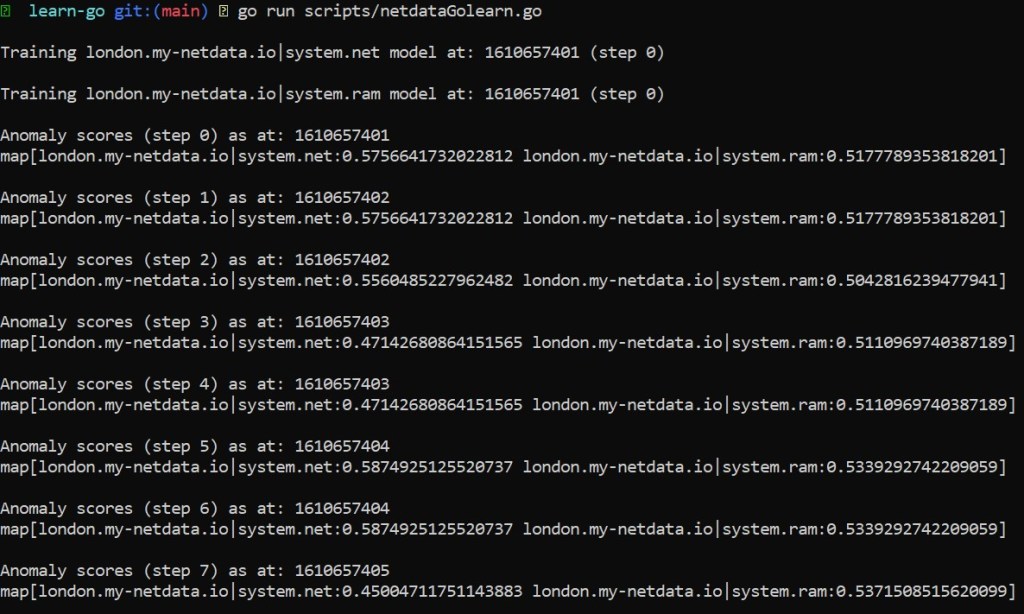Time series anomaly detection in Go using GoLearn

Output of the Go script.
I’ve posted recently about learning just enough Go to be dangerous over the christmas break, well here is a update on my adventures so far.
The below script (which is probably horrible in places if you know Go properly - tips welcome) uses goroutines to pull data from some REST API endpoints and then use GoLearn to train a model and start producing anomaly scores for new observations.
package main
import (
"encoding/json"
"fmt"
"io/ioutil"
"net/http"
"sync"
"time"
"github.com/sjwhitworth/golearn/base"
"github.com/sjwhitworth/golearn/trees"
"gonum.org/v1/gonum/mat"
)
// Create a wait group
var wg sync.WaitGroup
// Struct used to unmarshal json from netdata api
type netdataResponse struct {
Labels []string `json:"labels"`
Data [][]float64 `json:"data"`
}
// Get instances from the netdata api
func getInstances(host, chart, after, before string, lags, diffs, smoothing int, c chan map[string]base.FixedDataGrid) {
// Need to make sure we tell wait group we done
defer wg.Done()
// Create response
var data netdataResponse
// Get response from netdata rest api
resp, _ := http.Get("https://" + host + "/api/v1/data?chart=" + chart + "&format=json&after=" + after + "&before=" + before)
bodyBytes, _ := ioutil.ReadAll(resp.Body)
// Unmarshal into netdataResponse
_ = json.Unmarshal([]byte(bodyBytes), &data)
// Flatten data into one slice, ignoring the first column which is always "time", and adding nLags
nDims := len(data.Labels) - 1
nCols := nDims + (lags * nDims)
nRows := len(data.Data) - lags
// Make flat slice to put data into
dataFlat := make([]float64, nCols*nRows)
// Loop over and add lags to flat data
i := 0
for t := range data.Data {
//fmt.Println(data.Data[t])
if t >= (lags + diffs) {
for dim := range data.Data[t] {
// Ignore time which is the first dim in the response
if dim > 0 {
// Add each lag
for l := 0; l <= lags; l++ {
if diffs > 0 {
dataFlat[i] = data.Data[t-l][dim] - data.Data[t-l-diffs][dim]
} else {
dataFlat[i] = data.Data[t-l][dim]
}
i++
}
}
}
}
}
// Create instances
instances := base.InstancesFromMat64(nRows, nCols, mat.NewDense(nRows, nCols, dataFlat))
//fmt.Println(instances)
// Must set a class attribute in golearn
// Ok to just use any feature as per comment here:
// https://github.com/sjwhitworth/golearn/issues/260#issuecomment-756086922
attrArray := instances.AllAttributes()
instances.AddClassAttribute(attrArray[0])
// Create map for data so we can later identify what comes back from the channel
instancesMap := make(map[string]base.FixedDataGrid, 1)
instancesMap[host+"|"+chart] = instances
// Send to channel
c <- instancesMap
}
func fitModel(instances base.FixedDataGrid, nTrees, maxDepth, subSpace int) trees.IsolationForest {
forest := trees.NewIsolationForest(nTrees, maxDepth, subSpace)
forest.Fit(instances)
return forest
}
func main() {
// How many steps to run for
var nSteps = 30
// How often to retrain models
var trainEvery = 15
// define config for each chart we want and anomaly score for
var host = "london.my-netdata.io"
var trainAfter = "-100"
var trainBefore = "0"
var lags = 1
var diffs = 0
var smoothing = 2
config := map[string]map[string]interface{}{
"1": {"host": host, "chart": "system.net", "trainAfter": trainAfter, "trainBefore": trainBefore, "lags": lags, "diffs": diffs, "smoothing": smoothing},
"2": {"host": host, "chart": "system.ram", "trainAfter": trainAfter, "trainBefore": trainBefore, "lags": lags, "diffs": diffs, "smoothing": smoothing},
}
// Create map to store trained models in
trainedModels := make(map[string]trees.IsolationForest, len(config))
// Run for nSteps
for i := 0; i <= nSteps; i++ {
// Train models
if i%trainEvery == 0 {
// Get training data
trainDataChannel := make(chan map[string]base.FixedDataGrid, len(config))
// Get training data
for _, conf := range config {
wg.Add(1)
go getInstances(
conf["host"].(string),
conf["chart"].(string),
conf["trainAfter"].(string),
conf["trainBefore"].(string),
conf["lags"].(int),
conf["diffs"].(int),
conf["smoothing"].(int),
trainDataChannel,
)
}
wg.Wait()
close(trainDataChannel)
// Train each model and save it to trainedModels
for trainInstancesMap := range trainDataChannel {
for trainInstancesKey, trainInstancesData := range trainInstancesMap {
fmt.Printf("\nTraining %v model at: %v (step %v)\n", trainInstancesKey, time.Now().Unix(), i)
trainedModels[trainInstancesKey] = fitModel(trainInstancesData, 10, 10, 100)
}
}
}
// Get prediction data
predDataChannel := make(chan map[string]base.FixedDataGrid, len(config))
for _, conf := range config {
wg.Add(1)
go getInstances(
conf["host"].(string),
conf["chart"].(string),
//string(-1*conf["lags"].(int)+conf["diffs"].(int)),
"-20",
"0",
conf["lags"].(int),
conf["diffs"].(int),
conf["smoothing"].(int),
predDataChannel,
)
}
wg.Wait()
close(predDataChannel)
// Make predictions
preds := make(map[string]float64)
for predInstancesMap := range predDataChannel {
for predInstancesKey, predInstancesData := range predInstancesMap {
//fmt.Println(predInstancesKey)
//fmt.Println(predInstancesData)
model := trainedModels[predInstancesKey]
recentPreds := model.Predict(predInstancesData)
//fmt.Println(recentPreds)
preds[predInstancesKey] = recentPreds[len(recentPreds)-1-diffs]
}
}
// Print scores at each step
fmt.Printf("\nAnomaly scores (step %v) as at: %v\n", i, time.Now().Unix())
fmt.Println(preds)
time.Sleep(500 * time.Millisecond)
}
}